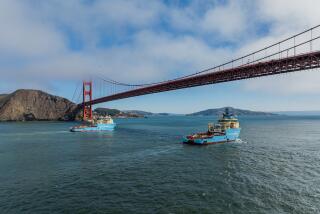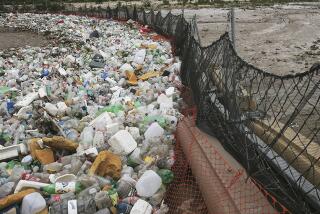Proposed Pipeline Would Add to Pollution Problem
I’m afraid I cannot bring myself to jump with joyful approval of Orange County sanitation officials wanting to build a new ocean outfall line to pump sewage sludge out eight miles to sea off Huntington Beach.
The proposed pipeline and the accompanying sludge treatment plant would follow the natural slope of the ocean bottom and deliver primarily treated sludge at depths of 1,000 to 1,300 feet of water. Initially, it’s estimated the project will cost $20 million.
Supporters claim the pipelinecan be experimental in nature and can be modified or abandoned if it doesn’t work. I agree with a Deparment of Fish and Game spokesman who believes that nobody has the right to experiment with marine biota unless it’s in an aquarium. Nobody should be in a rush to further pollute the sea, and it’s suffering plenty of damage from the burgeoning population that lives on our coastal slopes. Orange County sanitation districts already are pouring enough sludge, without benefit of secondary treatment, into the sea off the mouth of the Santa River right now without adding to the mess.
And it’s pretty much of a mess out there in the sewage department, according to a biologist and oceanographer from the University of Washington, Barbara Hickey. She is heading an academic study funded by the Department of Energy. For a couple of years the scientists studying our coastal waters effected by sewage disposal and other pollutants have put down a series of subsurface buoys containing various measurement devices. Two weeks ago, their buoys in the San Pedro Channel and in the Outer Santa Barbara Channel were pulled.
Hickey said it was too early to analyze the results, which will be presented at the December meeting of the American Geophysical Union. The studies have included the directions of subsurface currents, many of which rotate in circular patterns. None of them, it seems, exceed five knots.
The types of currents and visual observations in submarine vessels have shown that great strands of sewage, rich in poisons, are collecting in the deeps. “The coastal area is not an infinite reservoir,” said Hickey.
Perhaps if outfalls were established 50 to 100 miles at sea, the problem of marine biota pollution might not be so severe. But this is not being done.
Cost is a major factor in the political decision to dump sludge into the ocean. Additional secondary treatment plants and burning and converting sludge into fertilizer or its disposal in landfills is more expensive than seawater disposal. But either method can have serious environmental effects.
However, most environmentalists seem to believe that the higher cost of land disposal is more than offset by its more controllable nature than by shoveling it beneath the sea.
Since 1972 when the original Clean Water Act was passed it has been illegal, if not environmentally nasty, to pipe sludge into the ocean. The U. S. Environmental Protection Agency has opposed the planned Huntington Beach pipeline. The authorization for it awaits President Reagan’s signature.
I believe Reagan would be signing away a vast part of the health and viability of our coastal sea. I can only hope that our local sanitary officials restrain their intentions to sink that new pipeline at least long enough to learn what Barbara Hickey and her colleagues say about the present condition of our ocean deeps.
I suspect that all us who love the shore and sea are going to be appalled by the report about the condition of our ocean.
More to Read
Sign up for Essential California
The most important California stories and recommendations in your inbox every morning.
You may occasionally receive promotional content from the Los Angeles Times.









